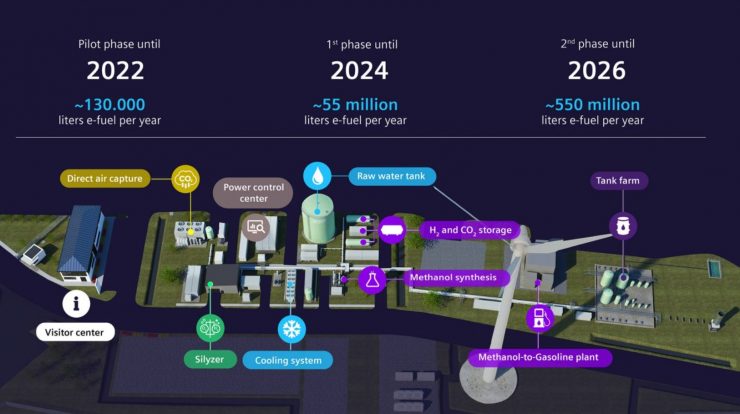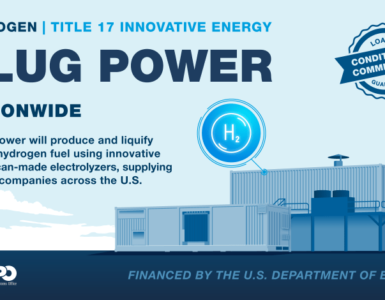Siemens Energy – A new hydrogen reality: Fuel from wind and water. The next step towards decarbonizing the global transport sector begins in a windy region in the south of Chile. Explore the Haru Oni project.
Decarbonizing transportation
Winds of change are blowing strong in the south of Chile. A new reality, fuel from wind and water with the purpose to decarbonize the transport sector, is underway.
Siemens Energy, alongside several international companies lead by HIF, is developing and implementing the world’s first integrated and commercial large-scale plant for the production of climate neutral e-fuel.
🔥 What about we co-host a webinar? Let's educate, captivate, and convert the hydrogen economy!
Hydrogen Central is the global go-to online magazine for the hydrogen economy, we can help you host impactful webinars that become a global reference on your topic and are an evergreen source of leads. Click here to request more details
Introducing the Haru Oni project (Highly Innovative fuels (HIF) pilot project), which is harnessing the strong and steady winds in the Magallanes, Chile’s southernmost region.
Why?
By channeling these powerful winds, we’re making good use of natural resources and exporting renewable energy in the form of liquid fuels. These e-fuels will be a big step towards the decarbonization of the transport sector.
The impact?
In the pilot phase, e-Methanol production will initially reach around 750.000 liters per year by 2022. Part of the e-Methanol will be converted to e-Gasoline (130.000 liters per year). In two steps, capacity is planned to be increased to 55 million liters e-Gasoline per year by 2024 and to over 550 million liters per year by 2026.
Green fuels
Why this matters
We’re committed to sustainability, and this project is one of many important steps we’re taking to decarbonize society. With Haru Oni’s focus on producing e-fuels (which will be supplied to Europe and other regions), we’re making promising strides to achieve the Green Deal.
READ the latest news shaping the hydrogen market at Hydrogen Central
The Green Deal is a commitment hailed from the European Commission to raising the EU’s climate target for 2030 that would lead to Europe being the first climate-neutral continent in 2050. The transport and industry sectors are together responsible for 45% of the world’s CO₂-emissions. However, in these sectors, renewable energy sources have only reduced emissions by less than 8%.
Decarbonizing transport and industry is more complex and costly compared with the power sector. This is why the EU is now also gradually including road traffic and the building sector in the emissions trading scheme. In addition, the Commission plans to significantly tighten the CO₂ fleet limits for passenger cars.
This is also exactly where – in combination with electrification – fuels generated from renewable sources will come into play – one important application of Power-to-X.
Power-to-X means, electricity is converted – preferably from renewable energy sources – to hydrogen or to hydrogen-based synthetic fuels and feedstock, which will then be applied in several sectors.
Pilot plant in Chile
Synthetic fuel
The Haru Oni project is demonstrating a broad spectrum of innovative, climate-relevant technologies at one location.
Synthetic fuel is produced from water, wind energy and CO₂ captured from the air. It is a liquid energy carrier that emits about 90 percent less CO₂ than the fossil counterpart. In case of e-gasoline it is simultaneously compatible with existing liquid fuel infrastructure.
Sustainable value chain
From green electrons to green molecules
The purpose of the Haru Oni project is to use Chile’s strong winds in The Magallanes region to generate climate-neutral fuel.
Why Chile?
Due to their excellent wind conditions and the resulting low electricity prices, Chile has a very high potential for the production, export and local use of green hydrogen in an international comparison. In addition, exports in the form of liquid fuels are the best way to take advantage of the wind energy readily available in Magallanes.
How the Haru Oni project works:
Clean wind energy will be used in the project to initially produce green hydrogen.
First, Electrolyzers use wind power to split water into its components, oxygen and hydrogen. Siemens Energy’s PEM (Proton Exchange Membrane) electrolysis with its high efficiency and flexibility is ideally suited to harness the volatile wind and solar energy.
Next, CO₂ is captured from the air and combined with the green hydrogen to produce synthetic methanol: The basis for climate-neutral fuels like e-diesel, e-gasoline or e-kerosene, that can be used to power cars, trucks, ships or aircrafts.
In a third process step, approximately 40% of the methanol is then converted into synthetic gasoline.
A new hydrogen reality: Fuel from wind and water, full article








